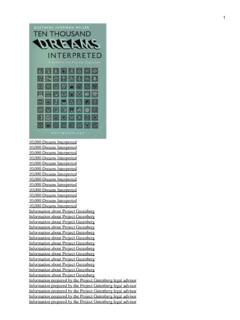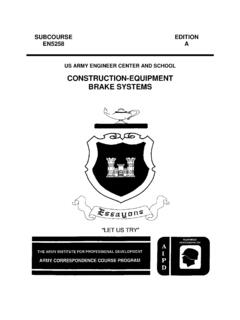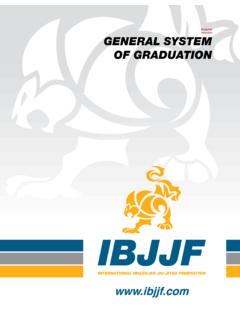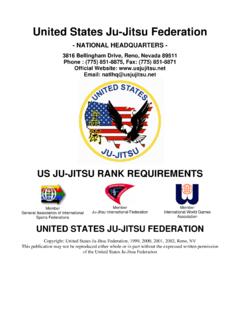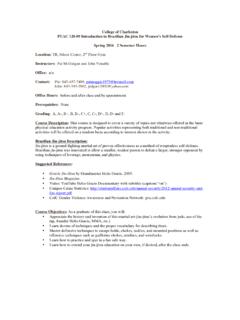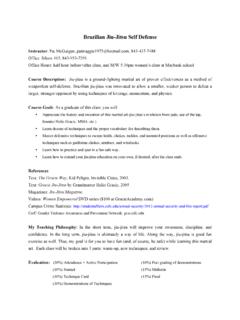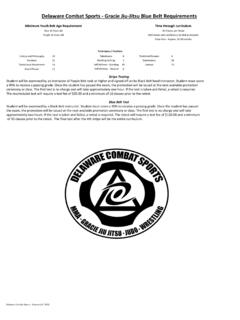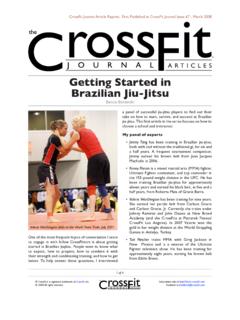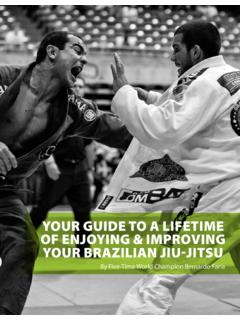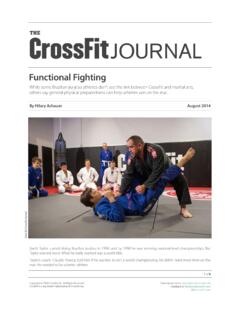Transcription of JIU-JITSU.NET E-BOOK - The Free Information Society
1 E-BOOKS amples from Brazilian Jiu-jitsu, The Master Text and Brazilian Jiu-jitsu, Basics By Gene "Aranha" SimcoWARNINGThe techniques presented in this book are dangerous. Before you begin your Brazilian Jiu-jitsu training, youshould consult a physician. You and your partner should always communicate with each other and stopwhen the other signals. All techniques should be practiced under the supervision of a qualified author of this book shall not be held liable for the misuse of any Information contained book is not a replacement for a qualified instructor. This book does not contain all of the moves thatmake up the art of Brazilian jiu-jitsu. Only the core moves from each position are E-BOOK is intended to give readers a sample of certain areas withinBrazilian Jiu-jitsu, The MasterText and Brazilian Jiu-jitsu, you read, you will notice that pages have been taken from differentsections and are put together (re-arranged) in this E-BOOK in an order according to the title of the E-BOOK , notthe order of the book the pages originally came reading this text, you may purchase another E-BOOK from us or purchase the book itself.
2 There is somuch material in The Master Text that even if you purchase all of our online E-books, you will still not haveall the material in the original text itself. Some text and content has been left out in this file due to the factthat it is on one subject area and is acting as an this material and thank you for your patronage and support."From a technical perspective, Brazilian Jiu-jitsu, The Master Text, by Gene "Aranha" Simco, is the best bookabout the popular grappling art I've seen to date."- --Lito Angeles, Black Belt Magazine (6/2002)What really sets this book apart from any other grappling book on the market is the fact that it really repre-sents where mixed martial arts is today. It explains Jiu-jitsu grappling and its different styles better then anyother book on the market.
3 "-5 Stars--Bill Lewis (12/2001)"One of my students got your book (The Master Text) and I personally think that is a great book . Very goodtechnique and also good pictures. You are just making easy for people to learn."--Gustavo Machado (BJJ Black Belt) (12/2001)SSttaannddiinngg TTeecchhnniiqquueess CChhaapptteerr OOuuttlliinneeClosing DistancePunch DefenseKick Defense29 Grab DefensesRear Choke DefenseBearHugDefenseHead LockDefense31 Techniques from the StandingPosition:As a beginner, much of yourpractice will be isolated to one spe-cific area of concentration for a par-ticular class period. Since the focusof Brazilian Jiu-jitsu for beginners ison groundwork and the body posi-tioning that occurs there, much ofyour "sparring" or free practice withresistance will occur with both partic-ipants starting on the knees.
4 Thereare many reasons for this that you willcome to understand over time, but toprovide you with a simple understand-ing: the more comfortable you are onthe ground, the more relaxed you willbe about engaging in the practice ofJiu-jitsu with full resistance. Manyparticipants are also initially hesitantdue to a natural feeling of clusterphobia that occurs while someone ispinning you on the floor. This hesita-tion is relieved by the separation ofspecific positions during training andpractice. Another reason for thisseparation is to "force" students tomove away from areas of natural skillin order to develop their weakerareas. This complete development ofJiu-jitsu's basic techniques is impor-tant before moving on to moreadvanced techniques.
5 Some stu-dents who may not be very proficienton the ground may choose to staystanding if given the opportunitywhile "sparring" starts standing. Thismay occur due to a natural fear of"losing" or elevated ego. Therefore,instructors of Brazilian Jiu-jitsu willusually start free sparring sessionson the knees and standing at sepa-rate times. In this next section, I have iso-lated the basic standing techniquesof Jiu-jitsu that most beginners willencounter during their first year oftraining. Practical application andbasic understanding of these tech-niques is required by most instructorsbefore promotion to blue belt canoccur. QuedasCalled "quedas' in BrazilianPortuguese, takedowns or throws arestanding methods of attackanddefense whose purpose is to bring anattacker to the ground through the 33use of balance, timing and most cases, Jiu-jitsu practitionersutilize basic principles of physicssuch as momentum, gravity and accel-eration to achieve the throw with min-imum effort and maximum to the ClinchMany great champions ofJiu-jitsu through its recent historyhave said, "If you have the clinch,you have good Jiu-jitsu.
6 " This is atheme that resounds stronglythrough the art's value as a tool forself -defense. The principle theo-ry is this: In any style of fighting,whether the intention of the com-batants is to achieve victorythrough the implementation ofstrikes or submission holds, onething is inevitable: most of the time,the participants will is simply when both part-ners "hold" each other while stand-ing. Once a Jiu-jitsu practitionerachieves the clinch, the ability ofhis opponent to strike with a greatdeal of force (damaging force) isgreatly reduced. After a level ofsafety is achieved by the use ofthis position, a skilled Jiu-jitsufighter will take his opponent tothe floor where any of the "groundpositions" previously soon to bedetailed will be to the ClinchIn this example to the left, Iam using a method of progressiveindirect attack to create an open-ing so that I may safely achievethe clinch figure 1, I throw a highstrike to my opponent s head.
7 Itis not my intention to strike myopponent. My intention is to givemy opponent time to raise hishand to defend my strike. Byraising his hand, he will create anopening at his waist where his armwould normally be blocking mefrom entering . You will noticethat I control his right hand withmy left hand as I throw the strikeso that my opponent does notstrike me with that hand as I closethe figure 2, I control hisarm as I finish closing the dis-tance, placing my head on hischest. My left hand will wraparound my opponent s waits sohe cannot move back and awayfrom me, creating distance thatwill enable him to to the Clinch 2 (Baiting)This method of getting tothe clinch is a baiting method.
8 In this situation, I place my legsat a close distance to my oppo-nent, but lean back slightly sothat my head is just out of myopponent s reach. In order toencourage my opponent toattempt a strike to my head, Ilower my hands away from myface. Two things make it safefor me to do so: -My head is out of his am anticipating the strike tomy my opponentthrows the strike (figure 2), Ilean forward. As I lean forward,I keep my hands up to protectmy face from both kicks I enter in figure 3, Ihold him with my left hand toprevent him from moving backand control his arm with my rightarm. I place my head to hischest in order to protect myface from from the ClinchOnce I have reached theclinch position, I must use itto my advantage.
9 Illustratedin figure 1, I drop to oneknee. I do so with my chestvery close to my opponent sleg, leaving him with very littlespace to (figure 2), I hug myopponent s legs at the knees,clasping both hands. Once I have control ofhis legs, I squeeze my armstogether, narrowing my oppo-nent s base. Once my oppo-nent s base is weak, I will drivemy head forward, pushing offmy right leg for power andsimultaneously pull his legstoward me. This movement will causemy opponent to fall backward(figure 3). As my opponentfalls, I will hug his legs tightly,squeezing them together as Imove around to one side of hisbody in order to control him. 12337 Defending a Punch (O Goshi)In this situation, myopponent attempts to punchme at a closer range.
10 Todefend, I raise my left hand tomy left ear, protecting theentire left side of my head (fig-ure 1). To protect myself frompotential counter strikes on myright side, I grab my oppo-nent s left in figure 2, Ipush my opponent s left handdown slightly to create spacefor me to enter . I will alsowrap my left arm over andaround my opponent s right order to lift my opponentoff the ground, I turn, facing thesame direction as him. During thisturn, I keep my hips lower than hisand bump into him, off-balancingmy opponent. My right arm goesunder his left arm and to his backwhile my left arm pulls his right tomy flip him over my back(hips) and throw him to the floor, Ipull down and to the left with my leftarm.



